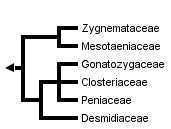
Classification
Domain: Eukarya
- Organisms whose cells possess membrane-bound organelles and a
true nucleus.
Kingdom: Protoctista
– Members of this kingdom do not fit into animals, plants, fungi, or
prokaryotes. Organisms in this group do not have much in
common other than simple organization.
Phylum: Chlorophyta
– Plants that range from a few inches to several feet in height that
live entirely submerged in water.
Class: Chlorophyceae
– Broad class consisting of fresh and saltwater, uni- and
multicellular green algae that is in filamentous or sheet-like
forms.
Order: Zygnematales
– Members of this group develop into unbranched filaments that are
one cell thick and grow longer through cell division.
Family: Zygnemataceae
– Organisms in this family are filamentous or unicellular,
uniseriate algae with diversely shaped chloroplasts.
Genus: Spirogyra
– The name ‘Spirogyra’ is derived from the spiral (helix)
arrangement of chloroplast in its filament-like body.
Species: Spirogyra Longata
-Filamentous green algae found in freshwater as skeins of thread.
These threads consist of individual cells that connect end-to-end.
Different sources have placed Spirogyra green algae into either the Plantae or Protoctista Kingdom. I have chosen to classify this organism as a protist, though it is believed to exist in an expanded ‘plant’ kingdom.
This phylogenetic tree is of the order Zygnematales. The conjugating green algae of this order lack flagellated cells. Families are distinguished by the structure of the wall and vegetative cell. Zygnemataceae and Mesotaeniaceae are closely related because they both have smooth unsegmented cell walls.
Next you will learn the usual Habitat that Spirogyra algae live in...
